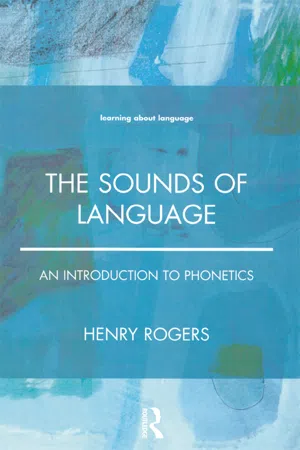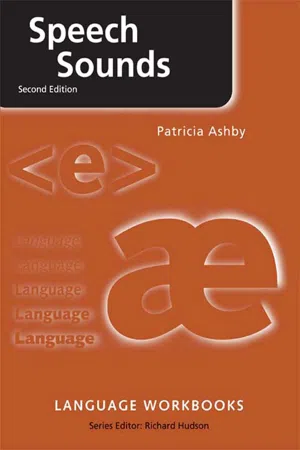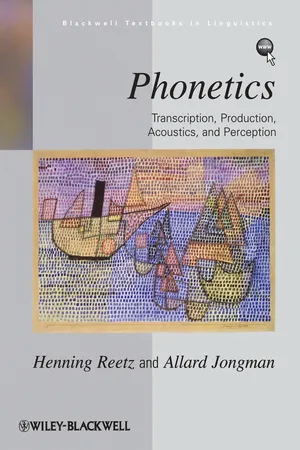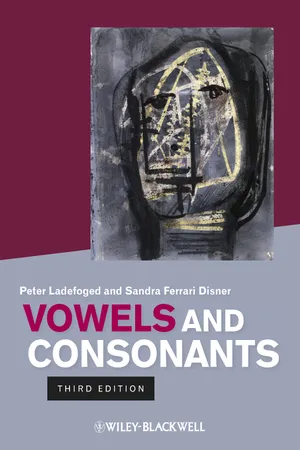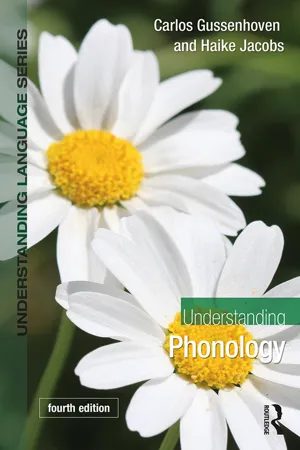Labiodental
Labiodental refers to a speech sound produced by the lower lip touching the upper teeth, as in the English sounds "f" and "v." This articulation involves the interaction of the lips and teeth and is a distinctive feature of many languages, including English. In phonetics, labiodental sounds are classified based on the position of the lips and teeth during articulation.
5 Key excerpts on "Labiodental"
- eBook - ePub
The Sounds of Language
An Introduction to Phonetics
- Henry Rogers(Author)
- 2014(Publication Date)
- Routledge(Publisher)
...High tone here is shown by [´] and low tone by [`]. Ewe Labiodental The lower lip articulates against the upper teeth to form Labiodental consonants (Figure 10.1). Labiodental stops do not occur distinctively although they are quite easy to make if your teeth do not have gaps. The Labiodental nasal [m] is reported in Teke (Laver, 1994). It occurs allophonically in English words like symphony where it is a homorganic nasal agreeing as to place of articulation with the following Labiodental fricative [f] or [v]. As noted in the preceding section on bilabials, languages commonly have bilabial stops and Labiodental fricatives. The transition next to a Labiodental consonant points down as with the bilabials (Figure 10.2). The fricatives have fairly faint noise. Figure 10.2 Spectrograms of bilabial and Labiodental stops and fricatives Linguo-labial Maddieson (1989) reports a very rare linguo-labial sound with the tip or blade of the tongue articulating with the upper lip. The IPA uses a gull-shaped diacritic for this place of articulation. Venen Taut (Austronesian, Vanuatu) Coronal Coronal sounds are made with the apex or lamina of the tongue. They include dentals, alveolars, alveolo-palatals, postalveolars, and retroflex sounds. Dental Dental sounds can be made with either the tip of the tongue, apico-dental, or with the blade, laminodental. The dental fricatives are voiceless [θ] theta and voiced eth. Other dental sounds are shown by using the alveolar symbol with the diacritic for example. Because in a given language all the stops are usually all dental or all alveolar, you will find that in discussing a particular language, the diacritic is commonly omitted with the assumption that you will know whether [t d n] represent dentals or alveolars. Dental fricatives with the blade of the tongue near the back of the upper teeth, can be made in addition to the dentals. Interdentals are made by thrusting the tongue slightly forward so that the tip protrudes between the teeth...
- eBook - ePub
- Patricia Ashby(Author)
- 2013(Publication Date)
- Routledge(Publisher)
...These established inherent relationships mean that, unless anything steps out of line (and the only thing flexible enough to do this, really, is the tip/blade section of the tongue) or if we want to be especially precise, it is not necessary to refer to the active articulator every time we mention a place of articulation. So, when the two lips articulate together (and you can see this happening twice if you look in your mirror and say baby) or the lower lip articulates with the teeth (and you can see this happening twice if you look in your mirror and say fever) we can say that all the consonant sounds being produced are LABIAL. Bilabial Labiodental The fact of the matter is that we do often need to distinguish between these two different kind of labial gestures (we would need to do this when describing consonant sounds in English, for example) and so we have two rather more precise place names for this purpose: BILABIAL (‘both lips’ for the consonants in baby) and Labiodental (‘lip and teeth’ for the consonants in fever). 5.4 Bilabial and Labiodental adjustments in vocal tract diagrams The lips and teeth in our sagittal sections or vocal tract drawings can be adjusted to show these postures (see Fig. 5.4). Labial–velar Double articulation Sometimes, two places of articulation are operated at the same time. This is the case in English [w], for example. You can see the lips are involved, but at the same time, the back of your tongue is making a movement (which although you can’t see it you may be able to feel a bit) towards the velum. [w] therefore has a sort of double-barrelled name: LABIAL–VELAR. DOUBLE ARTICULATIONS of this kind are rare, but to use two places at once is a recognized way of increasing the number of different sounds we are capable of producing. EXERCISES 5.4 Do not use the Table 5.1 for this exercise, but look at the diagrams in Figures 5.1 and 5.3...
- eBook - ePub
Phonetics
Transcription, Production, Acoustics, and Perception
- Henning Reetz, Allard Jongman(Authors)
- 2011(Publication Date)
- Wiley-Blackwell(Publisher)
...For example, the phrase Barcelona and Valencia is pronounced as [b]arcelona y [ β]alencia and the phrase Valencia and Barcelona as [b]alencia y [ β]arcelona (the y ‘and’ is pronounced as [i]). As can be seen, the initial sound of the two cities is pronounced as [b] when it appears at the beginning of the phrase but as a bilabial voiced fricative [β] after a voiced sound. That is, a Spanish speaker realizes a [b] or [β] depending on the context, that is, the phonemes surrounding it. Moving slightly back brings us to the Labiodental place of articulation. Labiodental plosives have not been attested, perhaps because it is difficult to create a firm complete constriction by touching the upper teeth with the lower lip. Labiodental nasals appear to be very rare. Teke-Kukuya, a Niger-Congo language spoken in the Congo (former Brazzaville), seems to be the only documented language with a phonemic Labiodental nasal [ɱ], as in [ɱíì] ‘eyes’ versus [ɱíì] ‘urine’ ([´] and [`] indicate high and low tones, respectively; see Section 11.4.1). The Labiodental nasal occurs in English as an allophone of bilabial [m] or alveolar [n] preceding [f, v] as in symphony [ˈsĩɱfə̃ni] or envelope [ˈɛ̃ɱvəloʊp]. In fact, most Labiodental nasals seem to be the result of coarticulation with a following Labiodental fricative. English has Labiodental fricatives [f, v]. While many languages have either bilabial or Labiodental fricatives, only a few languages contrast the two. An example is Ewe, a Niger-Congo language spoken in Ghana, that contrasts bilabial ([ɸ, β]) and Labiodental ([f, v]) fricatives, as shown in Table 4.2. Table 4.2 Examples of bilabial and Labiodental fricatives from Ewe A rare sound in the world’s languages is the voiceless Labiodental affricate [ p͡f ], where a bilabial plosive is released into a Labiodental fricative. This sound has only been attested in German and in Beembe, a Niger-Congo language spoken in Congo...
- eBook - ePub
- Peter Ladefoged, Sandra Ferrari Disner(Authors)
- 2012(Publication Date)
- Wiley-Blackwell(Publisher)
...Other languages, as we will see in Chapter 14, have both Labiodental fricatives f and v, and bilabial fricatives (for which the symbols are ɸ and β, to be found on the full IPA chart which will be discussed later). Some of the gaps in the consonant chart in Table 11.3 are because the combination of that particular place and manner cannot be made. The bilabial column has a gap in the last row because it is not possible to make a distinct bilabial lateral. You can close one side of your lips or possibly even close your lips in the middle and let air escape at the sides, but the sound you produce won’t differ from a regular bilabial. It is generally quite easy to describe the consonants in an English word. Try saying cling slowly. You can feel the back of your tongue touching the roof of the mouth for the initial velar stop consonant, k. Next, the tip of your tongue comes up to touch the roof of the mouth on the alveolar ridge for the alveolar lateral, l. After the vowel (for which the symbol is ɪ) the back of the tongue comes up again for the velar nasal, ŋ. The English spelling ‘ng’ at the end of a word is nearly always ŋ, and not a sequence of an alveolar n followed by a velar stop, ɡ. Sometimes it’s not so easy to feel what the tongue and lips are doing when producing a consonant. This is particularly true of the approximants in words such as watt, yacht, rot. You can see the rounding of the lips in w, but it is difficult to realize that the back of the tongue is raised. The j (‘y’) at the beginning of yacht has the front of the tongue raised. You may not realize this if you try to pronounce this sound by itself, but you can probably feel the way the tongue moves down and back as you pronounce the whole word. The ‘r’ sound at the beginning of rot is difficult to describe for two reasons...
- eBook - ePub
- Carlos Gussenhoven, Haike Jacobs(Authors)
- 2017(Publication Date)
- Routledge(Publisher)
...English [ʃ] in shore, [ӡ] in measure, [tʃ] in chip and [dӡ] in jet are articulated with the crown of the tongue, while the front of the tongue is raised towards the hard palate. Often, as in Dutch, the tip is held behind the lower teeth for this type of consonant, in which case the contact is alternatively labelled prepalatal. A postalveolar articulation with just the tip of the tongue occurs in English [tɹ̥] as in try. If this type of contact is made with the tongue tip or the underside of the tongue blade with the tongue tip curled back, the term retroflex is used. Like many languages spoken in India, Hindi has retroflex consonants like [ʈ ɖ ɳ], as in [t h əɳɖi] ‘cold’ and [g ɦ əɳʈa] ‘hour’. Labial If the lips articulate with each other, as in English [p b m] in spot, bell, mad, the place is bilabial. If the lower lip articulates with the upper teeth, the place is Labiodental. It is used for [f] in German [f iː] ‘cattle’ or French [fεʁ] ‘do’. 2.5.2 Types of constriction A first subdivision distinguishes between two kinds of constriction. A constriction that is tight enough to lead to friction when a (voiced or voiceless) airstream is passed through it, as used with obstruents. A type of constriction that allows a voiced airstream to pass through without friction, which is used for sonorants. In the case of obstruents, an acoustic source is actually created at the point of articulation: either a popping sound is produced (for plosives), or friction is produced at that spot (for fricatives and affricated plosives). The auditory quality of sonorants relies exclusively on the different shapes the vocal tract is given, i.e...
